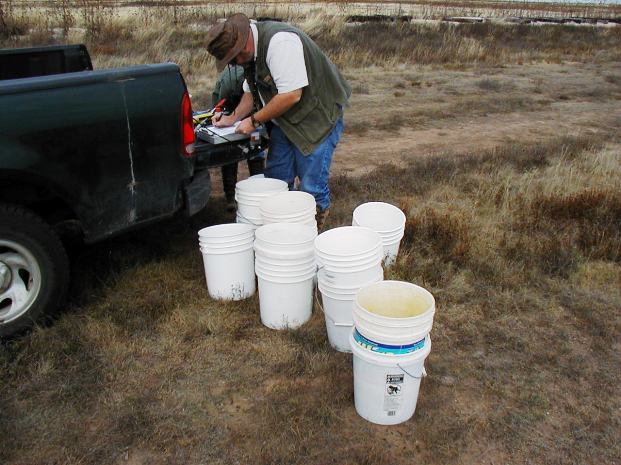Wild Pantex – Wildlife Research on the Texas Tech Research Farm
Article by Jim Ray, Pantex Wildlife Biologist/Scientist
The Texas Tech Research Farm is comprised of almost 6,000 acres of land lying between the Pantex Plant and U.S. Highway 60. Operated as a production farm and ranch, the land doubles as a safety and security buffer zone for Pantex.
Wildlife species typical of the High Plains of the Panhandle roam and feed in its prairies and croplands, and waterfowl and shorebirds are fond of two playa wetlands when Mother Nature is gracious enough to provide surface water. Like on the 12,000-acre DOE/NNSA portion of Pantex, during one of my trips across Texas Tech, I may encounter a herd of mule deer, a few white-tailed deer, a bald eagle, or even a bobcat wearing a G.P.S. collar around its neck.
Often, I spot a Texas horned lizard dash off the road ahead of me, and as I stop the vehicle it dives into escape cover on the side of the road. In this case, I locate the lizard, which in Texas, bears a state-threatened status designation. I catch it, and now this lizard will be marked and tracked, becoming one of many from the Texas Tech property to be part of a growing body of wildlife research being conducted there.
Formerly, a host for agricultural research relating to animal science, soils, crops, water conservation, entomology, and range management, little research had occurred on the Texas Tech property for the better part of two decades. Beginning in 2003, research on prairie rattlesnakes begin extending onto Texas Tech from the main Pantex property when a few rattlesnakes being radio-tracked by Pantex and Dr. Richard Kazmaier of West Texas A&M University (WTAMU), made excursions across the boundary between the two properties. My, how things have changed since that time!
Texas Tech Research Farm is now host to several Pantex-sponsored research projects, including work on bobcats, Texas horned lizards, and pre- and post-monitoring of birds in advance of wind energy development. In cooperation with Pantex staff, WTAMU’s Dr. Ray Matlack leads the work related to bobcats and wind energy, and besides work on rattlesnakes, Dr. Kazmaier also led the work on horned lizards. Dr. Clint Boal, USGS Texas Cooperative Fish and Wildlife Unit at Texas Tech University, has joined the collaboration on a portion of the work dealing with birds-of-prey nesting in and near the proposed turbine fields. A considerable amount of research has been performed by Texas Tech wildlife faculty and students at Pantex, but this was all on the adjoining USDOE/NNSA property.
Aside from the value of the information being generated by these studies, it is a great sight to see students, professors and Pantex staff conducting fieldwork across the site, which, depending on the occasion, might include the marking of a horned lizard, setting a trap for a bobcat, applying a radio-transmitter to a Swainson’s hawk, or conducting a survey for grassland birds.
As the name implies, the Texas Tech Research Farm and wildlife research are a great fit. Data from that property adds greatly to the information needs valued by Pantex in the realm of wildlife and habitat management.

Photo: Dr. Richard Kazmaier and buckets full of snakes marked during a Pantex research outing.
